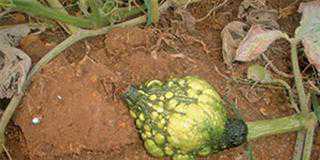In seedlings, you’ll sometimes see indistinct, greyish spots on the leaves. These develop ash-coloured centres with dark specks called pycnidia, which are the fruiting bodies. These plants will have purpling on the lower stems which starts to appear corky closer to the ground. If the stem is cut here, there’ll be black lesions inside.The fungal spores can be seed-borne but this is less of a problem than it used to be.
Lower chances of infection
When I started farming, we didn’t have hybrids or cavity seedling growers. Seed was cheap and used wastefully in soil seedbeds. Several seed companies sold these open-pollinated varieties and price was often the deciding factor as to which seed to buy. This meant seed producers couldn’t afford to spend too much on plant hygiene during production – if they made the seed too expensive, they’d lose sales.
This meant there was a greater chance of getting infected seed in those days. One still gets some seed batches with a slight infection, but this is becoming rare.In days of soil seedbeds, an infected plant could infest many seedlings by contact, weeding, and especially flood irrigation, which was common. With today’s seedling operations, an infested seed will be largely isolated.
Prevent blackleg
In the seedbed stage when the stems are still green and tender, you can still prevent the fungus from developing by spraying Benomyl at 1g/â„“ water with a wetting agent, thoroughly wetting the plants. This can be very effective as a weekly spray and if you still plant soil seedlings, do it as a matter of course.In the field, infected plants tend to start wilting without shedding leaves.
A seed-borne infection will affect the odd plant here and there and most farmers will consider it a curiosity rather than a problem, as the extent of the damage would be minimal. But the disease can spread to surrounding plants in warm, wet conditions, and ignoring infected plants is dangerous.
If you plant more cruciferous vegetables later in the same land, these patches will get larger. I once saw a land of Brussels sprouts where half the land was severely damaged and the other half completely healthy – the infected section had been planted to cabbages the year before and the healthy half to another crop. The farmer hadn’t even noticed infected plants. If it weren’t for the healthy section, the seedling grower would most likely have been blamed.
The fungus can live on seed for four years and on plant residue in the land for up to three, but it can’t survive once the old stalks of the crop have decomposed. This can take less than a year if the stalks are well incorporated and the season and soil conditions are favourable. Be careful if you can still see stalk residue in the land.
Zero tolerance
When you find occasional infected plants, remove them from the land and bury them. When you do find infected plants, also make a note to delay planting plants from the cabbage family again in that land for as long as possible, and check for crop residue before doing so.











